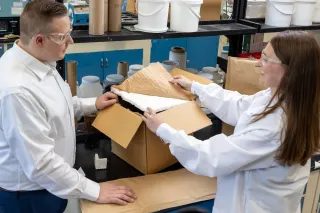Egg whites without chickens, chocolate without cocoa beans, animal protein and fats without meat production? These are concrete examples of cellular agriculture, which Business Finland is investing heavily in developing in a new €5 million research project. The CERAFIM project aims to achieve sustainable food production through biotechnology in collaboration between VTT and Finnish companies.
The green transition, circular economy and national carbon neutrality targets call for reduced emissions from agriculture and better utilization of side streams. The sustainability challenges of our current food system are manifold as the sector is responsible for about 25% of global CO2 emissions, more than half of which are caused by meat production. The situation is even more challenging for clean water, of which agriculture already consumes 75% globally.
"Global population is reaching 10 billion by 2050 and it's estimated that the demand for protein is set to double. We can't just increase production of conventional protein sources to meet that demand. Therefore we need a shift from conventional animal based protein sources to more sustainably produced alternative protein sources,” says Joosu Kuivanen, Chief Operating Officer, Eniferbio.
Cellular agriculture is based on the production of food and materials without fields or animal farming. Instead, food ingredients and material components are grown with microbes, algae, plant or animal cells in bioreactors. The cells can be fed with sugars derived from side-streams from agriculture forestry or the food processing industry. The so-called cell factories are capable of producing, for example, proteins, fats, carbohydrates, bioplastics and a wide range of chemicals or even whole cell biomass containing various components. This production method has enormous advantages over conventional agriculture.
“The environmental impact of cellular agriculture is estimated to be lower than that of conventional food production. *In particular, land use impacts are up to 90% lower compared to current food production, but also greenhouse gas emissions are significantly reduced, especially when renewable energy is used in the processes. Cellular agriculture could also offer a solution to the challenges of fair and transparent supply chains, and thus affect the social sustainability of food production," says Annika Porr, Senior Manager, R&D, Fazer.
Cellular agriculture is deeply rooted in traditional food production, with products such as tempeh or yeast spreads, but during the last ten years, progress in synthetic biology and industrial biotechnology have opened up completely new possibilities and led to a major leap forward in the field. VTT has long recognised the potential of cellular agriculture and has invested in research in this field.
In this new CERAFIM project, VTT’s know-how is joined with the expertise of nine Finnish companies to develop a more sustainable materials production and food system by combining biotechnology with circular economy. The project partners are Valio, Fazer, UPM, Kemira, Fortum Bio2X and emerging start-ups OnegoBio, Spinnova, eniferBio, High Metal and Brightplus.
“We focus on the actual technology development - how we can efficiently produce the proteins or lipids or the microbial biomass that can be used either for food or other applications like material solutions. In addition to development of the end applications, safety and regulatory issues are also addressed, especially from the viewpoint of using side-streams. Hence, the project takes a holistic view on the new value chain development," says Emilia Nordlund, Research Manager, VTT.
Finland is well positioned to be a forerunner in cellular agriculture and to turn both its know-how and new innovations into successful export products. Business Finland is now investing heavily in the development of cellular agriculture through this nearly €5 million project. CERAFIM is set to run for two years and is part of Business Finland’s Bio & Circular Finland programme. Its key vision is that by 2030, European consumers will accept cellular agriculture as one of the mainstream methods of food and material production. CERAFIM also offers a concrete opportunity to make the global materials production and food system both more sustainable and more equitable.
"What inspires me most is that cellular agriculture allows for nutrient-rich food production in areas where unfavorable climate or soil quality is restricting traditional agricultural production. Cellular agriculture can enable decentralised food production. And what is fascinating is that it can create equality for people all over the world," says Dilek Ercili-Cura, Senior research scientist, Valio.












